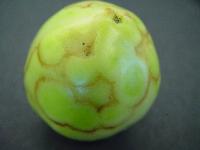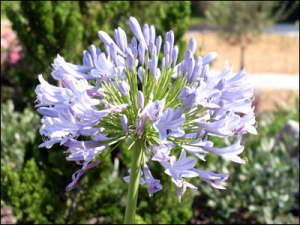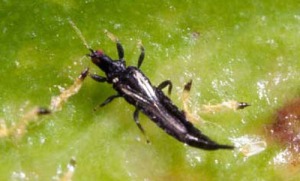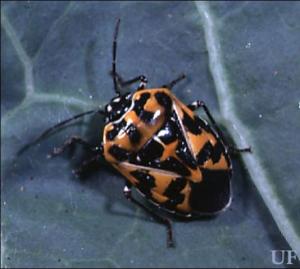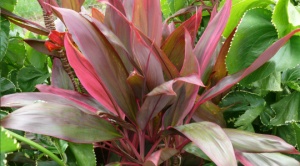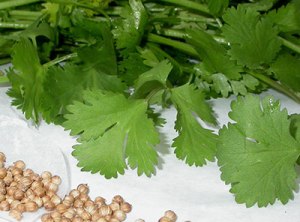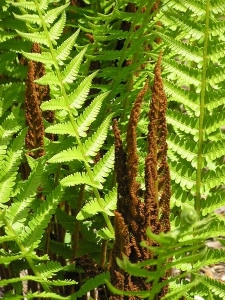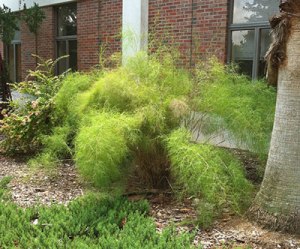A: This looks like the dreaded Tomato Spotted Wilt Virus (TSWV) which is transmitted by a small insect vector called thrips. The virus is transmitted to the fruit by the thrips piercing into the leaf and removing the plant fluid then injecting the virus into the plant. This virus has very wide host range, including tomato, pepper, potato, tobacco, lettuce and many other plants. Small, brown spots will show up on the leaves of the tomato first and we generally ignore them as they seem common to most vegetable plants. Ultimately, the spots turn brown then the whole leaf will die and droop or wilt on the stem. If you are scouting the green tomato fruit, you may see the next symptom which will be rings of yellow or brown with a lighter green color. Once the fruit turns red, the rings will be dark brown. Some successful cultural controls: use highly reflective UV mulch (metalized mulch) around tomatoes; control weeds in and around tomato or pepper fields; do not plant tomatoes and peppers near TSWV susceptible crops such as peanut or tobacco.
Author Archives: bobkat1177
Q: I purchased 10-10-10 fertilizer for my roses. How much do I use?
 A: The directions on the bag should address this for you, so when in doubt always refer to the label. But here is a good rule: apply 2 to 3 pounds per 100 square feet between two feedings in early spring (March – April). Apply an additional 1 to 2 pounds of balanced fertilizer per 100 square feet once buds form and continue every four weeks until mid-August. One (1) cup of garden fertilizer weighs about ½ pound therefore for 1 pound of fertilizer you will need 2 cups; for 2 pounds of fertilizer measure out 4 cups of 10-10-10 fertilizer per 100 square feet. It is important to remember the amounts listed above are NOT per rose plant but instead for a whole bed of roses. To determine the total square feet of the rose bed you will need to multiply the length of one side of the bed times the width of the other side. Remember when your math teacher told you arithmetic was important? Well, here you see it in action. One other helpful hint – it is always better to err on the side of less fertilizer rather than more especially as we get an increase in disease and insect feeding in the summer months. So please be judicious in applying fertilizer in warm weather.
A: The directions on the bag should address this for you, so when in doubt always refer to the label. But here is a good rule: apply 2 to 3 pounds per 100 square feet between two feedings in early spring (March – April). Apply an additional 1 to 2 pounds of balanced fertilizer per 100 square feet once buds form and continue every four weeks until mid-August. One (1) cup of garden fertilizer weighs about ½ pound therefore for 1 pound of fertilizer you will need 2 cups; for 2 pounds of fertilizer measure out 4 cups of 10-10-10 fertilizer per 100 square feet. It is important to remember the amounts listed above are NOT per rose plant but instead for a whole bed of roses. To determine the total square feet of the rose bed you will need to multiply the length of one side of the bed times the width of the other side. Remember when your math teacher told you arithmetic was important? Well, here you see it in action. One other helpful hint – it is always better to err on the side of less fertilizer rather than more especially as we get an increase in disease and insect feeding in the summer months. So please be judicious in applying fertilizer in warm weather.
Q: I had purple and white agapanthus. However, I now have only white flowers. Do the purple flowers change to white?
A: Interesting question. Although we know hydrangea flowers can change color by the soil pH we know agapanthus flower color is not subject to variation regarding soil pH. There are specific instances where variegated cultivars of shrubs, such as Chinese privet, Ligustrum sinense ‘Varigata’, may revert to the solid color invasive parent. But I have not heard of purple agapanthus flowers altering its color. However, I do know the purple cultivars are not as cold hardy as the white variety. I believe you told me yours were growing in pots which made them slightly more susceptible to any cold temperatures. It may well be the purple varieties did not survive our unseasonably cold snap this late spring whereas the white ones have reproduced and thrived.
Q: What is wrong with my ficus tree leaves? I have been using Neem oil and nothing is working.
A: The real cause of the issue is Weeping ficus thrips, Gynaikothrips uzeli. The thrips feed on expanding leaves causing purplish red spots on the lower leaf surface. The leaves become curled and galled, and prematurely drop. Treatments must be applied to protect leaves while they are expanding. Once damage has occurred and populations are developing in tightly curled leaves, adequate coverage with insecticides is extremely difficult. There are no specific recommendations for this thrips, however, pesticide recommendations for other types of thrips feeding on ornamental plants may work. Some research suggests drenching with dinotefuran (Safari) or acephate (Orthene) provided good control but I realize you are reluctant since you have a toddler and want to reduce any pesticide exposure to the child. Tip pruning of infested plants will remove the food source of the thrips in addition to any thrips and eggs present on these new shoots. These thrips are commonly preyed upon by a predatory bug, which many times causes the populations of thrips to drop. However, your plant is enclosed in a patio and will have little chance of getting a predatory insect. You may continue to treat it but you might consider removing the plant and throwing it away. If you decide to destroy the plant, consider placing it in a large lawn bag and tossing it in the garbage. I would not allow other landscape plants to be exposed to this pest. This information comes directly from the UF/IFAS Tropical Research and Education Center.
Q: Can you identify these insects for me? They are all over my kale and leafy vegetables.
A: These are some of the easiest insects to identify because of their beautiful coloration. Harlequin Bug, Murgantia histrionica, is an important insect pest of cabbage and similar crops in the southern half of the United States. Harlequin bugs can destroy the entire crop if not managed properly. This insect is classified as a piercing/sucking insect because it sucks the plant’s vascular tissue fluid. The removal of the fluid from the plant causes it to wilt, turn brown and ultimately die. Plants commonly attacked by the harlequin bug include crucifers such as horseradish, cabbage, cauliflower, collards, mustard, Brussels sprouts, turnip, kohlrabi, and radish. In the absence of these favorite hosts, tomato, potato, eggplant, okra, bean, asparagus, beet, weeds, fruit trees, and field crops may be eaten. Hand-picking and destroying the insect pests and egg masses may make a difference especially if small numbers of insects are detected. The easiest and most effective control of harlequin bugs is to hand remove them in the fall and spring before they have a chance to lay eggs. Chemical control can be accomplished by using insecticidal soap (not dish soap) on the young nymphs. Apply insecticidal soaps in early morning, before the bugs are active, to maximize effectiveness. Do not use neonicotinoid insecticides or broad spectrum insecticides as they can harm our important bee populations. http://edis.ifas.ufl.edu/in152
Q: Can it prune my Ti plant? It is getting too tall and blocking my view.
A: The colorful Ti plant, Cordyline terminalis, is perfect for creating a tropical landscape effect, with its smooth, flexible leaves ranging in color from variegated light greens and pinks to very dark reds. Performing well in full sun or partial to deep shade, Ti plants need fertile, well-drained soil and can tolerate only brief periods of drought. Leaf coloration is more pronounced in sunnier locations. This is truly a tropical plant specifically for cold hardiness zones 10-11. If we receive a cold winter, this plant will need to be protected. You can prune it down to 12 inches from the ground and it will regrow. Spring is the best time to do it, so make your pruning cuts now. http://edis.ifas.ufl.edu/fp141
Q: I am having trouble growing cilantro. Can you give me a couple of hints?
A: Cilantro, Coriandrum sativum, also known as Chinese parsley, is a form of coriander. While coriander is grown as an herb primarily for its seeds, the type of coriander referred to as cilantro is grown for the leafy portion of the plant. Cilantro leaves can be harvested early, once the plants reach 6 inches tall, and continuously thereafter until the plant dies. Cilantro should be grown in full sun to part sun and in well-drained soil, with a pH of 6.2 to 6.8. In Spanish-speaking areas, cilantro (also spelled culantro) usually refers to the plant, but may also refer to coriander seed. The main problem you are having is the time of year. Here in Florida, we consider cilantro a cool herb. This means we will be limited to growing it in the fall and late spring. Once temperatures get above 80°F the leafy portion will fade out but you can continue to allow it to grow and produce the coriander seed in the warmer weather. Ground coriander seeds are the main ingredient in the Indian “garam masala” spice mix. The roots are even used in Thai curries. Many of us taste a soapy flavor when we eat the cilantro leaves. It is believed to be caused by a specific fat molecule called aldehyde, which is also found in soaps. Some scientists believe the soapy flavor is caused by an odor the herb displays. Regardless, for many people cilantro is just not an herb they will be warming up to any time soon. http://edis.ifas.ufl.edu/mv051
Q: I need some ideas on plants rabbits won’t eat.
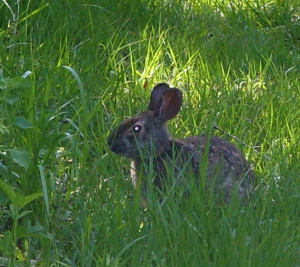 A: Unfortunately, if the animal is hungry enough they will eat most anything. They particularly like vegetable garden plants and most anything in the rose family which includes many of our fruit trees. However, there are a few plants rabbits seem to avoid such as agaves, aloes, Gaillardia spp., cucumber, shrimp plants, euphorbias, plumbago, rosemary, squash, verbena or yucca. Now, I know someone will call me and tell me they know one of those plants listed was eaten by a rabbit, but remember, if the rabbits are hungry enough anything edible is susceptible. You can use one of the repellents which may help reduce or prevent rabbit damage. These products work by creating an unpleasant odor, taste, or stickiness.
A: Unfortunately, if the animal is hungry enough they will eat most anything. They particularly like vegetable garden plants and most anything in the rose family which includes many of our fruit trees. However, there are a few plants rabbits seem to avoid such as agaves, aloes, Gaillardia spp., cucumber, shrimp plants, euphorbias, plumbago, rosemary, squash, verbena or yucca. Now, I know someone will call me and tell me they know one of those plants listed was eaten by a rabbit, but remember, if the rabbits are hungry enough anything edible is susceptible. You can use one of the repellents which may help reduce or prevent rabbit damage. These products work by creating an unpleasant odor, taste, or stickiness.
Apply repellents before damage occurs, and reapply them frequently, especially after a rain, heavy dew, or sprinkler irrigation or when new growth occurs. In all cases, follow the label directions for the repellent.
The usefulness of repellents is limited. Most, except for some of the taste repellents, can’t be used on plants or plant parts humans eat. Repellents often fail when used in a vegetable garden even if the repellents are registered for use on edible crops. The story of Peter Rabbit should be a warning to us; rabbits will get into a garden – it is just too tempting.
Q: Can I grow cinnamon fern here?
A: You certainly can grow the native cinnamon fern, Osmunda cinnamomea, here in Northeast Florida. Cinnamon fern has a compact, horizontal rhizome which is easy to grow but prefers moist to wet soil in sun or shade. This is why you often see cinnamon fern growing in the swampy areas. It may go dormant with dry soil and be slow to establish but it is a long-lived plant. One other important note – it is seldom damaged by deer. It can grow to about 2 feet tall but will die back in the winter. It’s most distinctive feature is the bright cinnamon colored fertile fronds, produced in late spring which will die by mid-summer.
Q: What can you tell me about the muhly bamboo grass?
A: I am hoping to have some Bamboo muhly, Muhlenbergia dumosa, at the Master Gardener plant sale on May 13. Bamboo muhly blends the look of bamboo with the easy versatility of an ornamental grass. With its billowy, light green foliage, bamboo muhly can anchor a perennial bed, serve as a screen, or give height to a container planting. The upright or arching stems can reach four to six feet tall, and the plant can reach up to five feet wide as the clump slowly spreads. Be sure to allow for the necessary spacing. Bamboo muhly is native to Arizona and northwestern Mexico and is somewhat drought tolerant, once the plant is established. This means it should not be planted under the eaves of houses if the eaves have no gutters. Bamboo muhly is usually evergreen, though the foliage will likely die back if the plant is exposed to freezing temperatures. If this happens, prune back the brown foliage just before growth starts in the spring. Older canes of bamboo muhly can also be removed periodically to give the plant a fresh look and to encourage new growth. It was one of the 2010 Florida Plants of the Year.

